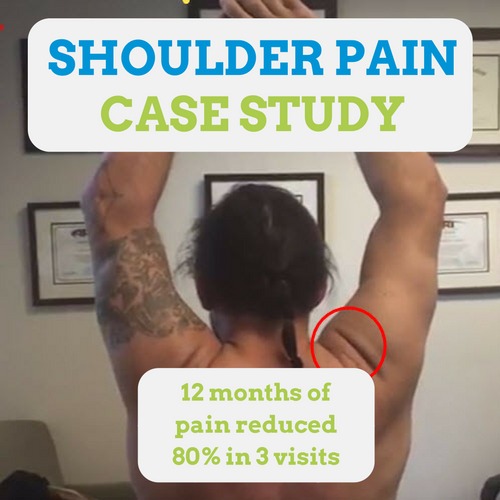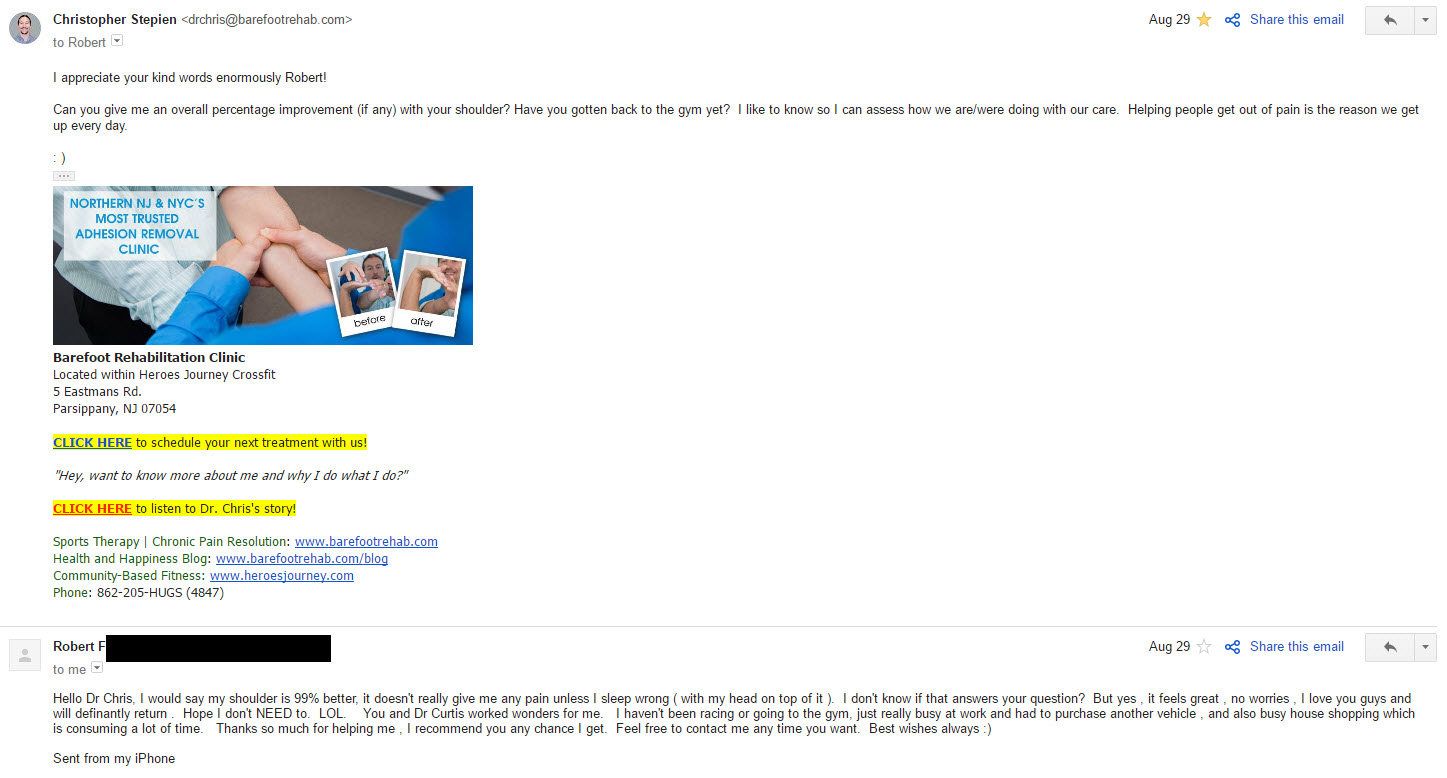
28 Sep 12 Months of Pain in Right Shoulder: A Case Study
When you get any type of healthcare (especially if it’s for pain in the right shoulder), how often do the doctors follow-up with you, months or years later, to determine just how successful the treatment was?
I don’t want to pick on anyone, but I will. Many surgeons claim to get astronomically high results with their patients. Then, that patient will step foot into our office to get their chronic pain resolved.
What’s going on here?
The surgeon will often do the surgery, do a follow-up with the patient after post-operative physical therapy when the patient is feeling pain-free, and then never see the patient again. Often, the pain will come back years later if the pain wasn’t still present at the time of follow-up.
At Barefoot Rehab, we reach out to random patients months or years after they’ve been discharged from our care to see how effective we were.
This is what we did with Robert.
Pain in Right Shoulder: Case Study
Below is an actual email exchange between a discharged patient who had pain in the right shoulder and myself.

Here was Robert’s reply in case you can’t read it in the picture:
Hello Dr Chris, I would say my shoulder is 99% better, it doesn’t really give me any pain unless I sleep wrong ( with my head on top of it ). I don’t know if that answers your question? But yes, it feels great, no worries, I love you guys and will definately return. Hope I don’t NEED to. LOL. You and Dr Curtis worked wonders for me. I haven’t been racing or going to the gym, just really busy at work and had to purchase another vehicle , and also busy house shopping which is consuming a lot of time. Thanks so much for helping me , I recommend you any chance I get. Feel free to contact me any time you want. Best wishes always 🙂
When a patient has been discharged from the doctor’s office four months prior and is still able to do everything he loves with 99% less pain, that’s called chronic pain resolution.
When your pain is resolved, you don’t need chronic pain management.
What was Robert’s Story?
Robert came in with pain in his right shoulder, rated as 10 out of 10, that started twelve months prior. He felt the pain when he moved his arm overhead, performed when he put a shirt on or took it off. He noticed “tingling” in the back of his forearm when driving and both of his hands (the entire hand, front and back) went number after riding his dirt biking.
Robert’s range of motion looked like this:
As evidenced by the title of that video, we told him that he has a problem (probable labrum tear) that would need to be identified by arthogram, but we can treat 3-5 times and see if we get results.
His initial diagnosis, in order of importance, was:
- Structural problem in the shoulder (needing an arthogram).
- Adhesion in the rotator cuff.
- Cervical disc pathology with nerve root involvement worsened by sitting.
- Radial nerve entrapment at teres minor.
After three Manual Adhesion Release treatments (provided by Integrative Diagnosis therapists) to his rotator cuff, his pain was 80% better in the shoulder. The last 19% of shoulder improvement occurred over the next ten treatments. Interestingly, the hand numbness he experienced when dirt bike riding went away in his right hand.
A diagnosis isn’t complete until a patient is discharged. Until that point, the pain story always changes.
The final diagnosis was:
- Adhesion in the rotator cuff (causing the shoulder pain) – formerly #2
- Adhesion in the subscapularis entrapping the brachial chords (causing the hand numbness) – formerly non-existent.
- Structural problem (needing an arthogram) – formerly #1.
- Cervical disc pathology with nerve root involvement worsened by sitting – formerly #3.
Notice the shuffling of priorities. This must happen in the doctor’s mind constantly as a chronic pain issue is unlayered, kind of like peeling off layers of an onion. Once pain becomes chronic, a single problem has grown into multiple problems. The body is really good at compensating and does so effectively for decades.
Think about it.
When you were ten years old, let’s say that you fell out of a tree. You probably cried for a hot minute, then jumped up and continued playing. It isn’t until you turn 40, 50, or 60 that pain becomes rampant among all of your friends. This is because your body loses the ability to compensate as you’ve damaged all replacement body parts.
Observe the new pathology in the above list (#2 – adhesion in the subscapularis) that was discovered with treatment. We didn’t expect the hand numbness to go away. But luckily, it did. We hit two birds (pain in right shoulder and right hand numbness) with one stone (treating the rotator cuff muscle subscapularis).
Addressing the #1 and #2 problem from the 2nd list allowed Robert’s pain to be reduced 99%, allowing him to do more of the dirt-bike riding he loves.
We expressed to Robert that the #3 and #4 problems most likely exist as evidenced by the way he moved his shoulder in the video. Therefore, he should be careful not to stress the shoulder joint and neck too much over his lifetime (respecting the laws of load and capacity). This advice is extremely important in preventing the joints from degenerating (growing the arthritis) faster than it would otherwise.
Lessons You Can Learn From Robert
Any chronic pain patient that has his pain reduced provides sign posts for you and your pain.
1. 10/10 Pain is Not To Be Messed With – Get a Diagnosis!
Robert had his pain for a year. Luckily, he came in for treatment when he did. Because he likely has a labrum tear (or other structural shoulder problem), stressing that type of problem more is like asking for a total shoulder replacement in the very near future.
No one ever regretted doing less.
People, who have constant pain that cannot be alievated, always regret the abuse they did to their bodies.
2. Pain Often Is Caused by Multiple Problems
Pain cannot be successfully reduced to ONE problem.
While we specialize in one problem at Barefoot Rehab, adhesion, that does not mean we can ignore the other factors contributing to the pain.
Any healthcare provider who says there is one problem to your pain should raise a red flag in your mind.
3. Communicate With Your Doctor(s)
Assuming you have doctors you like and trust, keep exchanging information with him or her. The more data you collect and analyze, the better you can plan for the future. Save your MRIs, xrays, reports, and paperwork in a file at home for future use.
The goal is to live a long, healthy life where you do the things you love to do, pain-free.
Staying in communication ensures that your body will stay happy.
Do you h ave pain in your right shoulder? What have you tried? What are you thinking about after reading the lessons Robert’s shoulder is teaching us?
ave pain in your right shoulder? What have you tried? What are you thinking about after reading the lessons Robert’s shoulder is teaching us?

No Comments